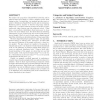Free Online Productivity Tools
i2Speak
i2Symbol
i2OCR
iTex2Img
iWeb2Print
iWeb2Shot
i2Type
iPdf2Split
iPdf2Merge
i2Bopomofo
i2Arabic
i2Style
i2Image
i2PDF
iLatex2Rtf
Sci2ools
127
click to vote
PODC
2004
ACM
2004
ACM
Analyzing Kleinberg's (and other) small-world Models
We analyze the properties of Small-World networks, where links are much more likely to connect “neighbor nodes” than distant nodes. In particular, our analysis provides new results for Kleinberg’s Small-World model and its extensions. Kleinberg adds a number of directed long-range random links to an n×n lattice network (vertices as nodes of a grid, undirected edges between any two adjacent nodes). Links have a non-uniform distribution that favors arcs to close nodes over more distant ones. He shows that the following phenomenon occurs: between any two nodes a path with expected length O(log2 n) can be found using a simple greedy algorithm which has no global knowledge of long-range links. We show that Kleinberg’s analysis is tight: his algorithm achieves θ(log2 n) delivery time. Moreover, we show that the expected diameter of the graph is θ(log n), a log n factor smaller. We also extend our results to the general kdimensional model. Our diameter results extend traditional w...
Distant Nodes | Distributed And Parallel Computing | Kleinberg’s Small-world Model | PODC 2004 | Show |
Related Content
| Added | 30 Jun 2010 |
| Updated | 30 Jun 2010 |
| Type | Conference |
| Year | 2004 |
| Where | PODC |
| Authors | Charles U. Martel, Van Nguyen |
Comments (0)

